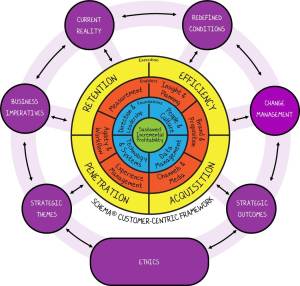Designing and executing a customer-centric business model requires end to end organisational alignment. Customer-centric capability development cannot take place in isolation to the rest of the business. The customer-centric journey requires a clear quantified understanding of current organisational capability across all 14 capability areas of the SCHEMA® Customer Management framework in the centre of the REAP Customer-Centric Blueprint below. As important as an understanding of current customer management capability is, so too is an understanding of the capability to which the organisation aspires.
Each week I’ll address another single capability area, sharing with you the Transformation Intent to which your organisation should commit to, as well as ‘What Good Looks Like’ for those organisations that have achieved a fairly high level of maturity in the respective capability area.
The REAP Customer-Centric Organisation Blueprint®
This week we are dealing with Penetration which is one of the four Execution capability areas represented. The Execution layer relates to the capabilities and control levers needed to optimise customer value and includes Retention, Efficiency (understanding cost to serve), Acquisition and Penetration (customer development, cross-sell and up-sell) – collectively referred to as REAP. These are capabilities and initiatives that can be optimised in the short term.
These capabilities support your ability to implement your chosen customer strategies and rely on the fundamental building blocks (Foundations) as well as the Enabling capabilities already discussed in Part 1 to 10 of this series of blog posts.
Each of the four Execution capability areas is made up of sub-components. The Penetration dimension relates to the ability to develop more value from existing customers through cross-sell and up-sell activities to improve return on customer investment. Formal management of high value customers and key accounts is a critical part of this. It also requires clarity as to how you deal with low value customers from a development perspective, if at all. The 3 sub-components of the Penetration dimension are ‘Understanding Customer Value,’ ‘Increasing Customer Value,’ and ‘Managing High Value Customers.’ Each of these areas is addressed in separate, individual blog posts.
Transformation Intent – Penetration
“Delivering sustainable and superior business performance requires the on-going development and growth in the value of your customer base. To do this you need to have an in-depth understanding of your customer value so that you can identify opportunities to increase this value. This potential uplift is then supported through relevant propositions, cross-selling, up-selling, indirect value creation and expansion of existing product usage. In treating different customers differently, high value customers should also be given special attention so that the right team equipped with the necessary budget can deliver on their specific needs.”
What Good Looks Like – Increasing Customer Value
- Value development is managed as a business discipline (like acquisition or retention) with: clear ownership / responsibility; detailed planning; specific propositions; checks that it is generating incremental value.
- Active stimulation mechanisms are in place to increase usage / value / frequency of purchasing the organisations’ core products.
- Opportunities to sell ‘up’ to a higher level of value are sought and supported by appropriate offers, especially at point of sale.
- Cross-selling is driven through both outbound and inbound channels, based on clear rules-of-engagement and prompts to ensure appropriate offers are made from the organisation’s whole portfolio.
- Low value customers are identified against clear definitions and specifically dealt with so as to drive up their value or at least prevent it being made worse.
- The valuation of customers and stimulation of this value extends beyond pure transaction value, into areas such as advocacy and referral.
For more insight into customer-centric business model innovation as well as more insight into this particular area of the REAP Customer-Centric Blueprint, please see my book “The Customer-Centric Blueprint’ – http://amzn.to/ZILg4y




